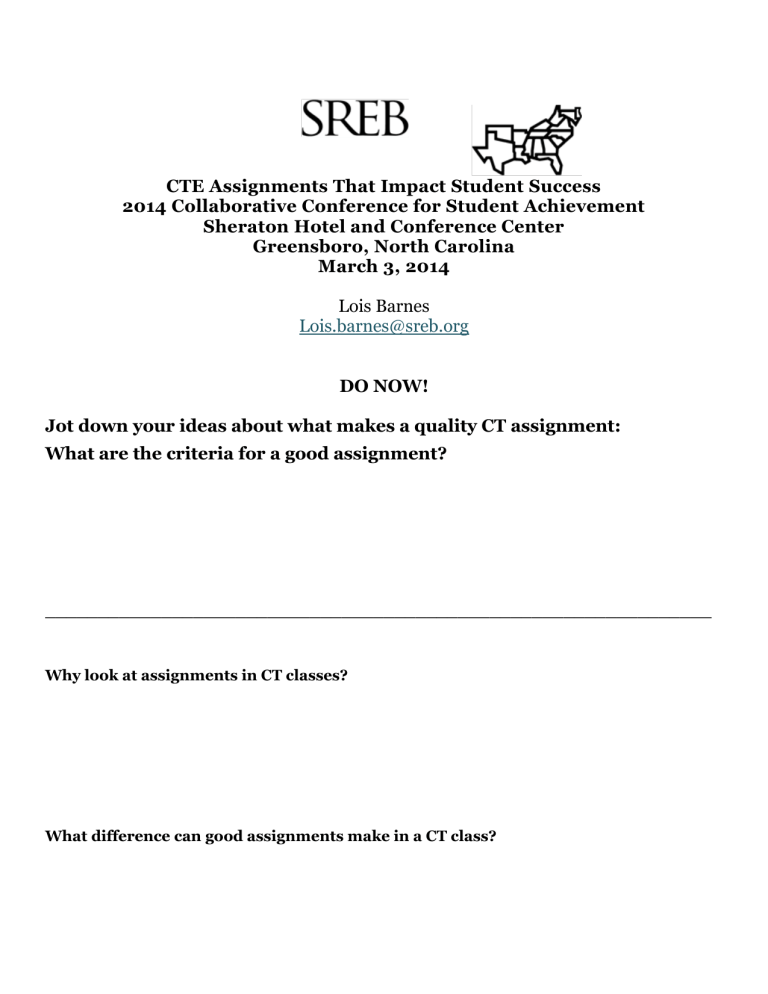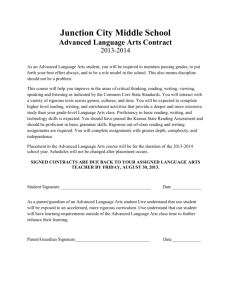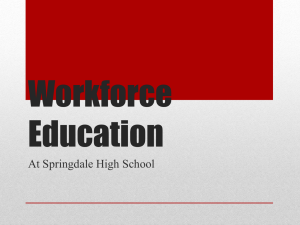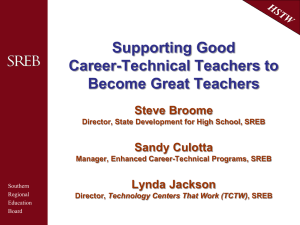CTE Assignments That Impact Student Success Sheraton Hotel and Conference Center
advertisement

CTE Assignments That Impact Student Success 2014 Collaborative Conference for Student Achievement Sheraton Hotel and Conference Center Greensboro, North Carolina March 3, 2014 Lois Barnes Lois.barnes@sreb.org DO NOW! Jot down your ideas about what makes a quality CT assignment: What are the criteria for a good assignment? _______________________________________________________________ Why look at assignments in CT classes? What difference can good assignments make in a CT class? Rigorous CT Indicators from HSTW Assessment Student Survey 1. 2. 3. 4. 5. 6. 7. Develop a logical argument for a solution to a problem or project. Make inferences from information provided to develop a solution for a problem or project. Use math to solve complex problems related to their career/technical area. Apply academic knowledge and skills to their career/technical area. Apply technical knowledge and skills to new situations. Develop and test hypotheses/project idea. Complete an extended project that requires planning, developing a solution or product, and presenting the results orally or in writing. 8. Predict outcomes based on observations or information provided. Developing CTE Assignments That Impact Student Success: Collaborative “Enhanced CT” Twelve Step Process Core Academic Teachers CT Teachers Business/Industry and Postsecondary Partners Step 1: Step 2: Step 3: Step 4: Step 5: Step 6: Step 7: Step 8: Step 9: Step 10: Step 11: Step 12: Authentic District and School Leadership CT Assignments and Projects Determine Business/Industry and Postsecondary Needs Brainstorm Project Ideas with Business/Industry and Postsecondary Input Develop Project Idea Develop Project Description using a “Real-Work” scenario Determine the “Essential” Academic and 21st Century Standards Determine the Design/Problem Solving Process for the Project Develop the Project Launch – Ask/Inquire/Diagnose Develop “Just in Time” ” Instruction for Students to Develop Possible Solutions – Imagine/Identify the Problem/Find Possible Solutions Develop “Just in Time” Instruction for Students to Plan the Solutions – Plan/Relevant Information/Work Plan Develop “Just In Time” Instruction for Students to Create the Project or Solution to the Problem – Create/Conceptualization/Take Action Evaluate the Project or Solution and Make Adjustments Based on Data Collected – Experiment/Evaluate/Analysis/Improve Deliver through a Written Document and/or Oral Presentation the Final Project or Solution to the Problem – Communicate/Implementation/ Deliver Final Product Project Description Template: Project’s Critical Focus Question: You are a (insert a real-workplace role). You are faced with (insert a problem). You must (insert what must be done to solve the problem). Technical Prompt: Design, build and test OR Investigate, conduct, analyze and using appropriate technology and software and 21st -century skills students will exhibit. Reading and Writing Prompt: Research on history, theory, contemporary use, what is known about how to address the problem AND writing an authentic document. Science Prompt: Design and conduct inquiry of a testable hypothesis under a variety of conditions OR Using the engineering design process to solve a technological problem. Math Prompt: Collect, analyze and chart on performance and conditions; reasoning with math, applying math Once you have decided on a course of action, you will (insert an opportunity for presentation to an authentic audience). Problem-Solving Design Process Comparisons SREB Design Process Engineering Design Process Troubleshooting Process Identifying the problem Diagnose the Problem Web Design Process Ask/Inquire Nursing Process Life Cycle Design Assess Diagnosis Plan Relevant Information Find Possible Solutions Visualization Planning Design Create Conceptualization Take Action Implementation Intervention Build Experiment/ Evaluate Improve Communicate Evaluation and Analysis Implementation Scientific Method Define Question Measure Research Analyze Hypothesis Define Requirements Initialization Imagine Business Methodology Evaluate and Analyze Verification Evaluate Deliver Final Product Gratification Report Test Develop Implementation Evolution Test Analyze Deliver Communicate Do your school’s career-technical (CT) programs serve the needs of business and provide instruction for students to be college- and career-ready for careers in the 21st century? SREB’s Enhanced CT Program: Providing Students with Relevant and Challenging CT Assignments and Programs Core Academic Teachers CT Teachers Business/Industry and Postsecondary Partners Authentic District and School Leadership CT Assignments and Projects Enhanced CT’s goal is for CT courses to use a sequence of authentic and rigorous workplace projects that deliver technical standards and provide students with the technical and academic skills necessary for college and career success. Enhanced CT’s support method has two components. First, SREB provides CT teachers with training and follow-up coaching on designing robust project assignments. Participants assess and adjust a current CT assignment or develop a new idea into a project assignment to conform to HSTW’s key indicators of robust CT experiences including embedding academic skills and standards to be mastered. CT teachers and academic teacher representatives collaborate to develop enabling learning activities to address technical and academic standards and technology skills students must use to complete the project assignment. The second component focuses training and coaching on developing a sequence of project assignments for each CT course in a program to teach the established curriculum. In the training, CT teachers meet with their business/industry and postsecondary partners and core academic teacher representatives to review the program’s courses and determine a sequence of real-world scenario ideas to teach the course’s standards. CT teachers and academic teacher representatives collaborate to expand the scenarios into authentic and rigorous workplace project assignments based on the training from component one. Enhanced CT Support Programs’ Recommended Training/Coaching Plan: Component One recommended training: an initial two days of training followed by a day of coaching, another two days of training followed by a day of coaching; a day of training followed by a day of coaching, and a final day of training and planning. Component Two recommended training: an initial two days of training followed by a day of coaching; two additional one-day trainings, each followed by a day of coaching. Contact Information: Gene Bottoms Sandy Culotta gene.bottoms@sreb.org sandy.culotta@sreb.org Director, State Initiatives of High School and Middle Grades Scott Warren Rhenida Rennie Lynda Jackson scott.warren@sreb.org rhenida.rennie@sreb.rog lynda.jackson@sreb.org Senior Vice President Director, State Development Manager, Enhanced CT Programs Director, Direct Services Network Steve Broome steve.broome@sreb.org Director, TCTW CTE Assignments That Impact Student Success 2014 Collaborative Conference for Student Achievement Greensboro, North Carolina March 3, 2014 Southern Regional Education Board Lois Barnes Lois.barnes@sreb.org Do Now! What are the indicators for a quality CT assignment? Jot down your ideas in the space provided on page one of your handout. Southern Regional Education Board What is SREB? Southern Regional Education Board What are SREB’s initiatives? Southern Regional Education Board • • • High Schools That Work Technology Centers That Work Making Middle Grades Work Focus Session Objectives Southern Regional Education Board Participants will be able to: Explain how assignments can have an impact on students career- and college success Analyze the criteria of CT assignments that impact student success Develop a first draft of a project description that contains the components of a quality project description Why look at Assignments in CT Classes? Southern Regional Education Board Relook at Mission, Goals and Practices In Light of Rising Workplace Requirements and Opportunities Southern Regional Education Board “The new economy requires not just white-collar workers but also workers with outstanding technical skills and highly developed problem-solving abilities. These workers will be the backbone of tomorrow’s prosperity.” Source: A Sharper Focus on Technical Workers How to Educate and Train for the Global Economy. NGA Center for Best Practices, 2010. “Employers are increasingly giving up on the American man.” Today, 81 percent of men between 25 and 54 hold jobs compared with 95 percent in 1969. Southern Regional Education Board Median wages for men between 20 and 50 dropped 27 percent to $33,000 a year from 1969 to 2009. “The Slow Disappearance of the American Working Man.” Bloomberg BusinessWeek, August 29-September 4, 2011. 8 What Employers Say about the Skills Gap: Southern Regional Education Board High school is the last education opportunity paid for wholly by the public. It’s purpose has to be to do the best it can to provide all who leave it the foundation necessary to enter, or further prepare for, adult life. Southern Regional Education Board Barton, 2006 Refer to your Do Now! What did you say are the indicators for a quality CT assignment? Southern Regional Education Board CT Assignment Indicators from HSTW Assessment Student Survey Southern Regional Education Board Develop a logical argument for your solution to a problem or project. Make inferences from information provided to develop a solution for a problem or project. Use math to solve complex problems related to your career/technical area. Apply academic knowledge and skills to your CT area. Apply technical knowledge and skills to new situations. Develop and test hypotheses. Complete an extended project that requires planning, developing a solution or product, and presenting the results orally or in writing. Used computer software or other technology related to your CT area to complete assignments weekly. SREB’s Enhanced CT Programs Providing Students with Relevant and Challenging Career-Technical Courses Technical Content Business and Industry Needs Southern Regional Education Board Academic Content Enhanced CT Programs Indicators of Rigorous CT Students Southern Regional Education Board 1. Develop a logical argument for a solution to a problem or project 2. Make inferences from information provided to develop a solution for a problem or project 3. Use math to solve complex problems related to my CT area 4. Apply academic knowledge and skills to my CT area 5. Apply technical knowledge and skills to new situations 6. Develop and test hypotheses 7. Complete an extended project that requires planning, developing a solution or product and presenting the results orally or in writing 8. Use computer appropriate technology to complete assignments or projects in their CT classes HSTW/TCTW Student Survey What difference can good assignments make in a CT class? Southern Regional Education Board Students Meeting Collegeand Career-Readiness Goals CT Students Meeting Readiness Goals Student Experiences Percent Meeting HSTW Readiness Goals Southern Regional Education Board Rigorous CT No Rigorous CT n = 7989 n = 14590 Reading 69% 46% Mathematics 66 48 Science 67 45 Source: 2012 HSTW Assessment Note: CTE Students only Impact of Rigorous CT Courses on Academic Achievement Percentage of CT Students Meeting College and Career-Readiness Goals 80% 70% 69% 67% 66% 60% 50% 48% 46% 45% 40% 30% 20% Southern Regional Education Board 10% 0% Reading Mathematics Had Rigorous CTE No Rigorous CTE Based on HSTW’s 2012 Student Survey and Assessment Note: Based on approximately 22,500 CTE students, does not include non-CTE students. Science Impact of Rigorous CT Courses on Academic Achievement Percentage of CT Students Meeting HSTW College-Readiness Goals Rigorous CT Impacts Achievement CT Students HSTW Curriculum n = 3438 Southern Regional Education Board HSTW Difference Curriculum + Rigorous CT Courses Rigorous CT Make Courses n = 2760 Meet Reading Goal 63% 80% 17% Meet Mathematics Goal 65 78 13% Meet Science Goal 61 78 17% Source: 2012 HSTW Assessment Note: CTE Students only Carousel Brainstorming: What do these indicators look like in a class? Let’s create a set of “look fors” with questions to ask students when observing a CT class. Southern Regional Education Board Sample Develop a logical argument for your solution to a problem or project. Southern Regional Education Board Look Fors Students work in teams (cooperative learning) Questions Why did you choose this solution? Carousel Brainstorming: What do these indicators look like in a class? Southern Regional Education Board Divide up into groups (count off by eights) Each group goes to their number poster Two minutes Look fors when walking into a classroom; questions to ask students Rotate one poster to your right; repeat When back to you original poster, review and report out Enhanced CT Goal Provide students with rigorous career-technical education (CTE) embedded with college- and career-ready academic standards and 21st-century skills for preparation for middle-skill, highdemand and high-wage careers that will provide the students resources needed to support a family of four. Southern Regional Education Board Enhanced CT Program Collaborative Components CT Teachers Business/Industry and Postsecondary Partners • Multiple Perspectives • Aspects of Industry • Middle-Skill Jobs • Technical and Academic Content • Standards Alignment • Just in Time Instruction • Habits of Success Authentic CT Projects Core Academic Teachers District and School Leadership • Support • Resources • Fidelity Step One Assess Business and Industry Needs Identify what students must know and be able to do to obtain and keep a job in the business that will support a family of four. Southern Regional Education Board Step Two Brainstorm Ideas What authentic project will take two to four weeks to complete and require students to master technical, academic and 21st-century skills to complete successfully? Southern Regional Education Board Step Three Develop a Project Choose one project idea from your list and develop a draft project description: • Project Title • Critical Focus Question • Brief, one-sentence description of what students will perform or produce Southern Regional Education Board Step Four Develop a Project Description You are: You are faced with: You must: Southern Regional Education Board Once you have decided on a course of action: Step Five Identify “Essential” Academic Standards and 21st-Century Skills • Choose one project from the brainstorming activity • Identify embedded academic skills (literacy, mathematics, etc.) • Identify appropriate 21st-century skills Southern Regional Education Board Step Six Use a Design/Problem-Solving Process in Projects • Leads to development of a new product or system • Ensures creation of only the products most likely to succeed • Acknowledges no such thing as “the design process” Southern Regional Education Board Problem Solving Process Comparisons SREB Design Process Engineering Design Process Ask/Inquire Identify the problem Imagine Troubleshooting Process Diagnose the Problem Find Possible Solutions Plan Find Relevant Information Work Plan - Steps Create Conceptualize Take Action Evaluate and Analyze Evaluate and Analyze Implement Deliver Final Product Experiment/Evaluate Southern Regional Education Board Improve Communicate Problem Solving Process Comparisons SREB Design Process Ask/Inquire Imagine Plan Create Southern Regional Education Board 4 Ps Web Design Prepare: Materials Methods Machines Manpower Initialization Experiment/Evaluate Perform Improve Perfect Visualization Implementation Verification Gratification Communicate Progress Problem Solving Process Comparisons SREB Design Process Nursing Process Ask/Inquire Assess Imagine Diagnose Plan DMADD© Business Methodology Define Define Requirements Plan Design/Build Experiment/ Evaluate Intervention Test Improve Evaluate Implementation Communicate Report Evolution Create Southern Regional Education Board Life Cycle Design Measure Analyze Develop Deliver Step Seven Inquire Develop the Project Launch. Southern Regional Education Board Step Eight Imagine Develop “Just in Time” ” Instruction for Students to Develop Possible Solutions . Southern Regional Education Board Step Nine Plan Which mini-tasks (“just in time” instruction) do students need so they can plan how to organize their work? Southern Regional Education Board Step Ten Create • How will students carry out the plan they developed? • For which skills will students need “just in time” instruction to complete their project? Southern Regional Education Board Step Eleven Experiment/Evaluate/ Analyze/Improve • How will students know if their projects are successful? • What steps do students need to complete to improve their projects? Southern Regional Education Board Step Twelve Communicate/Deliver Final Product/ Progress • How will students present the product to the authentic audience? • What “just in time” instruction do students need to prepare their communication/final product? Southern Regional Education Board How Do We Plan Quality CT Assignments That Impact Student Success? Southern Regional Education Board Developing the Project Idea: • Project Title • Critical Focus Question • Project Description You are a (insert a real-workplace role). You are faced with (insert a problem). You must (insert what must be done to solve the problem). Once you have decided on a course of action, you will (insert an opportunity for presentation to an authentic audience). Southern Regional Education Board The Critical Focus Question • • • • Southern Regional Education Board • Should cause students begin to inquiry and become engaged in the project Should be able to be answered through a variety of solutions Should not be answered by a simple “yes” or “no” Should cause students to make connections to prior learning and personal experiences Should be important over an extended period of time and transferable to other situations. Project Prompts Technical Prompt: Design, build and test OR Investigate, conduct, analyze and using appropriate technology and software and 21st-century skills students will exhibit. Reading and Writing Prompt: Research on Southern Regional Education Board history, theory, contemporary use, what is known about how to address the problem AND writing an authentic document Science Prompt: Design and conduct inquiry of a testable hypothesis under a variety of conditions OR Using the engineering design process to solve a technological problem Math Prompt: Collect, analyze and chart on performance and conditions; reasoning with math, applying math Now it is your turn • Project Title • Critical Focus Question • Project Description Southern Regional Education Board You are a (insert a real-workplace role). You are faced with (insert a problem). You must (insert what must be done to solve the problem). Once you have decided on a course of action, you will (insert an opportunity for presentation to an authentic audience). Feedback on Project Descriptions Warm Feedback I like how you phrased… I think your students will … You did a nice job… Cool Feedback Have you thought to include….? ISouthern wonder if you considered…? IRegional am not sure what you mean by this statement? Education Board Next Steps Professional Development Possibilities Outcomes for Training Southern Regional Education Board Enhanced CT Component One - Assignments Series of workshops with follow-up coaching to address level of rigor in CT assignments • Assess current assignments • Develop current or new project/assignment to meet the criteria for rigorous CT and Project Based Learning Standards Southern Regional Education Board Enhanced CT Component Two - CT Courses Southern Regional Education Board Series of workshops and coaching to assess CT courses and develop project experiences to teach the curriculum for each CT course • Involve business/industry in the process • Have academic and CT teachers work together • Create authentic projects Other Services from Enhanced CT Overview Sessions • Three hours to full-day customized visits • Webinars providing overview of programs and rigorous CT assignments • Virtual support Southern Regional Education Board Feedback from Workshop and Coaching Participants Southern Regional Education Board • Students will take a more serious approach to the time spent here. I want them to think of school as the “workplace” and not the ‘coffee shop. – August 2013 • The process is practical and really requires students to use critical thinking skills. – October 2013 • Students will be able to connect academics to my class and see the relevance. -- September 2013 • It will have us focus on academic standards and a “work-ready” project – October 2013 Lois Barnes Lois.barnes@sreb.org Southern Regional Education Board




